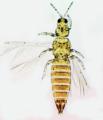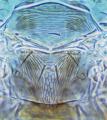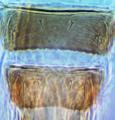Thrips imaginis
Recognition data
Distinguishing features
Both sexes fully winged. Body varying greatly in color from yellow to brown, legs yellowish; antennal segments I–III yellow, also base of IV; fore wing pale. Head wider than long; two pairs of ocellar setae; pair III small and arising just within ocellar triangle, posterolateral to fore ocellus; postocular setae pair I about as long as ocellar setae pair III, pairs II & III subequal. Antennae 7-segmented; III–IV with short forked sensorium; segment VII short. Pronotum with 2 pairs of prominent posteroangular setae; 4–5 pairs of posteromarginal setae. Metanotum reticulate medially, reticles elongate near posterior but equiangular just posterior to setae; median setae arising behind anterior margin; campaniform sensilla present. Fore wing first vein with 3 setae on distal half; second vein with about 18 setae; clavus with 5 marginal setae. Abdominal tergite II with 3 lateral marginal setae; tergites V–VIII with ctenidia present laterally, on VIII posteromesad to spiracles; tergite VIII posteromarginal comb absent medially, represented by a few irregular microtrichia laterally; pleurotergites with 1–3 discal setae. Sternite II with 2 pairs of marginal setae, III–V & VII usually with 3 pairs, VI commonly with 4 or 5 pairs; sternite II with 1–4 discal setae, III–VII with 12–24 discal setae in more than one irregular transverse row.
Male smaller than female; tergite VIII with no marginal comb; sternites III–VII with slender transverse pore plate anterior to row of discal setae.
Related and similar species
T. imaginis has not been found in California, but is included here because of its potential for invading the USA. The species is unusual within the genus Thrips because of the large number of discal setae on the abdominal sternites. A closely related, but consistently pale-bodied, species from northern Australia that is distributed across the Pacific, is T. safrus Mound & Masumoto, but in this the pleurotergites have no discal setae. The genus Thrips is the second largest genus in the Thysanoptera, and currently includes, worldwide, about 285 species. All members of this genus lack ocellar setae I on the head, and they all have ctenidia on tergite VIII posteromesad to the spiracles. Other characters, such as number of antennal segments, number of setae on the fore wing veins, and number of discal setae on the sternites are variable between species (Palmer, 1992; Mound & Masumoto, 2005).
Taxonomic data
Current valid name
Thrips imaginis Bagnall
Original name and synonyms
- Thrips imaginis Bagnall, 1926: 111
- Thrips fortis Bagnall, 1926: 109
- Thrips apicalis Bagnall, 1926: 111
- Neophysopus io Girault, 1927: 1
- Thrips shakespearei Girault, 1927: 1
- Neophysopus aureolus Girault, 1928: 3
- Aptinothrips apertus Kelly & Mayne, 1934: 33
Family placement
Thripidae, Thripinae
Common names
Australian Plague Thrips
Biological data
Life history
Breeding in flowers
Host plants
Highly polyphagous, living in the flowers of many unrelated native and introduced plant species in Australia.
Tospoviruses vectored
None
Crop damage
At one time considered a pest of pome fruits; sometimes reducing fruit set on grape vines.
Distribution data
Area of origin
Southern Australia
Distribution
Australia, New Zealand, New Caledonia; taken in quarantine in Netherlands. [not recorded from California]








